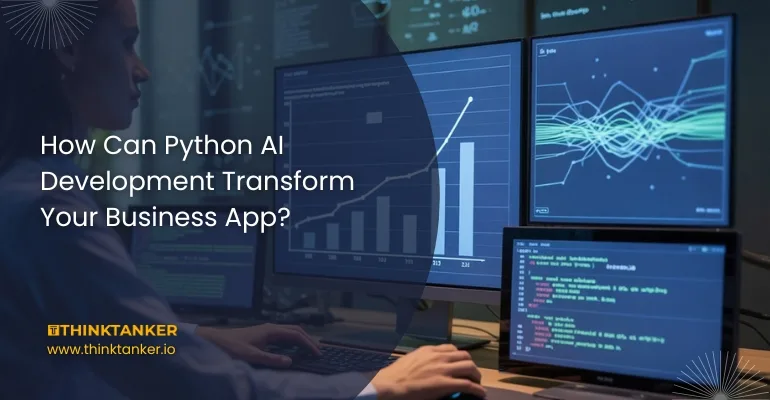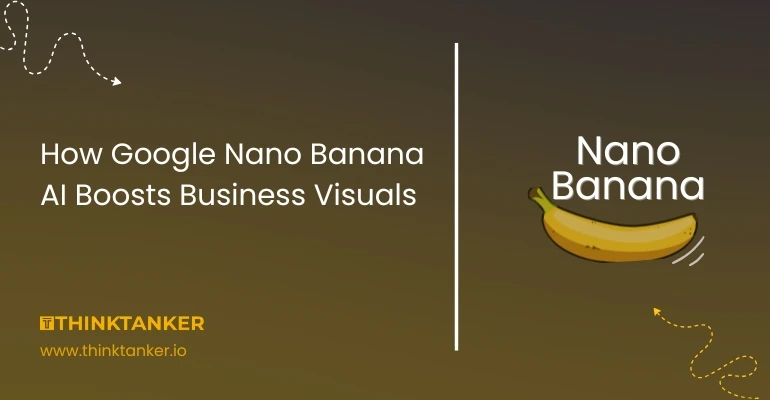How Can Python AI Development Transform Your Business App?

How Can Python AI Development Transform Your Business App?
Your competitors are probably already using AI. You’re not falling behind because the technology is complicated. You’re falling behind because you haven’t started yet.
Python AI isn’t some distant future thing. It’s happening now, in 2025. Companies are using it to automate work, understand customers better, and make smarter decisions. And honestly? It’s not as expensive or complicated as you think.
Let me show you what’s actually possible.
Why This Matters to Your Business (Right Now)
Think about the biggest problems your business faces:
- Too many manual processes eating up time
- Customer behavior you don’t understand
- Competitors who seem to know what customers want before you do
- Decisions made on gut feeling instead of data
- Money being wasted on inefficiency
Every one of these problems can be solved with Python AI. And I’m not exaggerating.
Here’s what’s happening: businesses that implement AI are growing faster, cutting costs, and gaining market share. The question isn’t “should we use AI?” It’s “how long can we survive without it?”
The good news? You’re not starting from zero. You already have the data. You already have the problems. You just need the right team to connect the dots.
What is Python AI Development?
Okay, let’s remove the mystery here. Python AI development isn’t magic. It’s practical problem-solving.
Traditional software is like a recipe. You tell the computer: “Do step 1, then step 2, then step 3.” Everything is explicit. The computer follows orders.
Python AI is different. You give the computer thousands of examples and let it learn patterns. Instead of you telling it exactly what to do, it figures out what to do based on what it’s learned.
Here’s a real example: Netflix doesn’t have programmers writing rules like “If the user watched action movies and it’s 8 pm on Friday, recommend an action movie.” That would be impossible. There are infinite combinations.
For example, Netflix doesn’t manually program rules like, “If a user watches action movies on Friday night, recommend another action movie.” That would be impossible because there are countless combinations.
Instead, Netflix trains its AI with millions of examples, user watch histories, ratings, and viewing times. The AI analyzes all that data and learns patterns such as, “People who enjoyed X and Y often like Z.”
That’s Python AI in a nutshell.
Now, why Python specifically for business?
Python is built for speed. You can get a working solution in weeks, not months. Your team can test ideas quickly without a massive investment.
Python has everything you need. There are pre-built tools for almost every AI problem. You’re not reinventing the wheel. You’re using battle-tested frameworks.
Python scales effortlessly. Whether you’re processing 100 data points or 100 million, Python handles it. Your business can grow without rearchitecting everything.
Python is an industry standard. Google, Amazon, Facebook, Netflix, they all use Python for AI. When you hire developers, they know Python. When you look for talent, you find people.
Python isn’t expensive. It’s open-source. Free tools. No licensing costs. Just pay for development and infrastructure.
Real Problems Python AI Actually Solves
Let me get specific. These aren’t theoretical benefits. These are problems real companies solved last year.
Problem #1: You’re Drowning in Manual Work
One of our clients was spending 40 hours per week on data entry and report generation. Humans copy information from one system to another. Mistakes are happening regularly. Delays everywhere.
We built a Python AI system that automated 85% of this work. Result? The team went from 40 hours a week to 6 hours. Same accuracy. No more human error.
Cost of the solution? Paid for itself in 2 months.
Problem #2: You Don’t Really Know Your Customers
Another client ran an eCommerce store. They knew who their customers were, but not really. They showed everyone the same products. One customer gets junk recommendations. Another sees perfect matches.
We implemented Python AI that learns each customer’s preferences. Personalized recommendations. Personalized emails. Personalized discounts.
Result? Average order value went up 23%. Customer lifetime value increased 35%. This is ongoing, every day.
Problem #3: Your Inventory is a Mess
A manufacturing company was either overstocked or understocked. Never quite right. Months of inventory sitting around, or urgent rush orders costing premium prices.
Python AI analyzed their sales patterns, seasonality, and lead times. It predicted what they’d need 3 months out with 92% accuracy.
Result? Inventory costs dropped 18%. Stock-outs (running out of product) dropped 70%. They’re not tying up money in excess stock anymore.
Problem #4: You’re Losing Money on Fraud
A fintech company was getting hit with fraud. Chargebacks. Disputed transactions. Manual review was slow and incomplete.
Python AI learned patterns of fraudulent transactions. Real-time detection. Real-time blocking. Only legitimate customers see friction.
Result? Fraud dropped 78%. Chargebacks cut in half. Customer experience improved because honest customers weren’t blocked.
Problem #5: Decisions Are Based on Guesses
A startup was deciding what to do next based on what the founder thought. No data backing it up.
Python AI gave them real insights: Which features do customers actually use? Which segments are growing? Which are churning? What’s the actual ROI of this marketing campaign?
Result? Better decisions. Less wasted money. Faster growth.
These aren’t special cases. These are patterns we see over and over.
The Money Part: What’s the Actual ROI?
I know you’re wondering: “Is this worth the investment?”
Here’s the reality: most Python AI projects pay for themselves within 3-6 months.
Case 1: Automation
Let’s say you have a process taking 20 hours per week. That’s one person’s time.
Cost per hour in India: ₹200-400 (salary loaded)
Hours per week: 20
Annual cost: 20 × 52 × ₹300 = ₹3.12 lakhs per year just on this one process
Python AI solution development cost: ₹8-15 lakhs
Payback: 4-5 months
After that? Pure savings. Year 2, year 3, year 10—that’s just profit. And you can deploy the same solution to multiple processes, multiplying the savings.
Case 2: Revenue Growth
An eCommerce store implementing personalization:
Current revenue: ₹50 lakhs per month
Personalization increases AOV (average order value) by 15-20%: ₹7.5-10 lakhs extra per month
Annual additional revenue: ₹90-120 lakhs
Development cost: ₹15-25 lakhs
Payback: 1.5-3 months
After that? ₹90-120 lakhs extra annually. This is recurring. This grows.
Case 3: Risk Reduction
A company reducing fraud by 50%:
Current fraud losses: ₹5 lakhs per month = ₹60 lakhs annually
Fraud reduction: ₹30 lakhs saved annually
Development cost: ₹20 lakhs
Payback: 8 months
Plus: Better customer trust, fewer chargebacks, fewer regulatory issues.
The math isn’t complicated. If the solution saves you money or makes you money in under 6 months, it’s almost always worth doing.
Where Does Python AI Actually Work in Your Business?
You don’t need to use AI everywhere. You use it where it creates the most impact.
eCommerce & Retail
Personalized recommendations: Show the right product to the right person at the right time. Every browsing session is unique. Every recommendation is tailored.
Dynamic pricing: Adjust prices based on demand, competition, and inventory. Optimize for revenue, not just volume.
Inventory prediction: Know what to stock before demand hits. Avoid stockouts. Avoid excess inventory.
Customer churn prediction: Know which customers are about to leave before they leave. Win them back with targeted offers.
Fraud detection: Block fraudulent transactions in real-time while letting legitimate customers through.
We’ve built these for eCommerce stores. The results are predictable and measurable.
Operations & Automation
Document processing: Extract data from PDFs, scans, and photos automatically. Errors drop dramatically.
Email and ticket automation: Classify incoming emails automatically. Route them. Prioritize them. Respond to common questions automatically.
Quality control: Identify defects in products, images, and data automatically. Catch problems at scale.
Supply chain optimization: Predict delays. Optimize routes. Minimize costs.
Customer Service & Support
Chatbots: Handle common questions automatically. Route complex issues to humans. Available 24/7.
Sentiment analysis: Understand customer emotions in support tickets. Prioritize unhappy customers.
Response suggestions: Analyze past solutions, suggest best responses to support staff. Faster resolution, higher satisfaction.
Business Intelligence
Forecasting: Predict revenue, customer growth, and market trends with real data.
Anomaly detection: Spot unusual patterns that humans miss. Catch problems early.
Customer segmentation: Group customers by behavior, not just demographics. Target the right message to the right segment.
Competitive analysis: Monitor competitors automatically. Spot trends. Adjust strategy.
The pattern? Wherever you have repetitive tasks, lots of data, or important decisions, Python AI probably helps.
How We Actually Build This (The Real Process)
You might be wondering: “Okay, this sounds great. But how does this actually work in practice?”
Fair question. Let me walk you through it.
Week 1-2: Discovery & Planning
We sit down with you. Not to pitch. To understand.
- What’s the actual problem you’re solving?
- What data do you have?
- What would success look like? (Concrete metrics, not vague goals)
- What’s your timeline?
- What’s your budget?
- What systems does this need to integrate with?
This phase is critical. We’re not here to sell you an expensive solution. We’re here to solve your problem efficiently.
Week 3-4: Data Preparation
Here’s the truth: 70% of AI work is data prep. It’s not glamorous. It’s cleaning, organising, and understanding data. But it’s critical.
- What data do you actually have?
- Is it clean or messy?
- Are there gaps?
- What needs to be combined?
Most companies think they don’t have enough data. They’re usually wrong. They have plenty. It’s just scattered and disorganised.
Week 5-10: Model Development
Now we actually build the AI.
- Develop the model based on your data
- Test it with historical data
- Refine based on results
- Optimise for your specific metrics
This isn’t a one-shot thing. It’s iterative. We build, test, learn, and improve. Build better, test better, learn more, improve more.
Week 11-12: Integration & Deployment
The model exists, but now it needs to actually work in your business.
- Connect it to your existing systems
- Build the interface (dashboards, reports, or automatic actions)
- Set up monitoring
- Train your team on how to use it
This is where it goes from theory to reality. This is where you actually see the benefit.
Ongoing: Monitoring & Improvement
The model doesn’t stay static. Markets change. Customer behaviour changes. Seasons change.
We monitor performance. We retrain with new data. We improve continuously. Every month, it gets a little better.
Why Companies Choose ThinkTanker for This
Look, you could try to build this yourself. You could hire developers directly. You could experiment with open-source tools.
Many companies do. Many regret it.
Here’s why ThinkTanker is different:
We’ve done this before. We’re not figuring it out as we go. We’ve built dozens of Python AI solutions. We know what works. We know what doesn’t. We know what takes 2 weeks and what takes 2 months.
We care about your business, not just the code. We ask “what problem are we solving?” not “how do we use the fanciest algorithm?” Sometimes the solution is simple. Sometimes it’s complex. We use what works, not what’s trendy.
We integrate with what you already have. You’re probably using Shopify, ERPNext, Laravel, and custom systems. We integrate smoothly. No rip-and-replace. No downtime. Minimal disruption.
We stick around. We don’t build it and disappear. We monitor. We optimize. We improve. We’re your ongoing technical partner.
We’re transparent on timeline and cost. No surprise bills. No “oh, this is actually more complex.” We understand the scope upfront. We communicate clearly. You know what you’re getting.
We can scale our team. Start with a small team to prove the concept. Once it’s working, we scale up. Need specific expertise?
We can hire specialized Python developers to augment your team.
Your Competitors Aren’t Waiting
Here’s the uncomfortable truth: your competitors might already be doing this.
The eCommerce store running personalization? Growing faster than you.
Is the SaaS company using predictive analytics? Making better decisions.
The logistics company is predicting demand. Cutting costs while you’re wasting money on inefficiency.
The gap widens every month. The longer you wait, the further behind you are.
This isn’t about being trendy. This isn’t about having the fanciest technology. This is about survival and growth.
What Happens Next?
You’ve read this far. You’re thinking about it. That’s good.
Now comes the actual step: talk to someone who does this.
Not to be sold something. To explore possibilities.
Here’s what we do:
- Free consultation: We understand your business. What problems are you facing? What’s your current process? What would success look like?
- Feasibility assessment: Is this a good fit for AI? What’s realistic? What’s the timeline and investment?
- Proof of concept: Start small. Prove the concept with a pilot project. Show real results. Then decide if you want to scale.
- Full implementation: If the pilot works, we scale it up. Integrate it. Monitor it. Optimize it.
No pressure. No sales pitch. Just an honest conversation about what’s possible.
Explore our Python Development expertise to see what we’ve built before.
Or check our portfolio to see real examples.
Ready to start?
Let’s talk. Or if you need dedicated developers to handle this in-house, we can help you hire experienced Python developers who know AI development.
Final Thought
Python AI isn’t the future anymore. It’s the present.
The question isn’t “should we do this?” It’s “why haven’t we done this yet?”
Your business has problems. AI solves them. The technology works. The ROI is real.
You don’t need to be a tech company to benefit. You just need the right partner who understands both technology and business.
Let’s explore what’s possible for your business.




